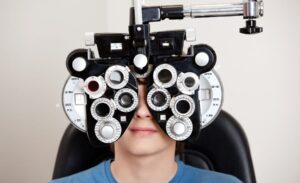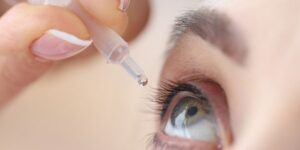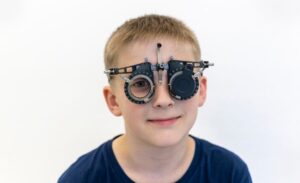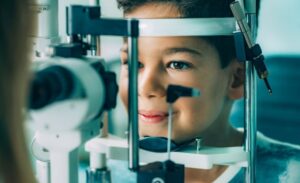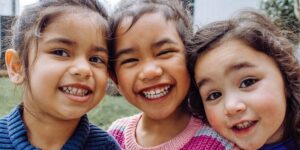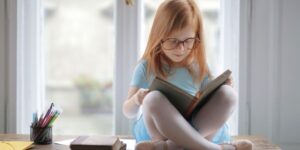To comprehend the concept of myopia control, it is essential to first understand what myopia is and why controlling it is crucial.
What is Myopia?
Myopia, commonly known as nearsightedness, is a refractive error that affects the ability to see distant objects clearly. Individuals with myopia experience clear vision up close but struggle to focus on objects in the distance. This occurs when the shape of the eye causes light to focus in front of the retina instead of directly on it.
Myopia often begins during childhood and can progressively worsen over time. The exact cause of myopia is not fully understood, but both genetic and environmental factors are believed to play a role. Spending excessive time performing near work, such as reading or using digital devices, has been associated with an increased risk of developing myopia.
The Importance of Myopia Control
Controlling myopia has become increasingly important due to its rising prevalence and potential long-term consequences. High levels of myopia have been linked to an increased risk of eye conditions such as cataracts, glaucoma, and retinal detachment later in life.
Early intervention and effective myopia control strategies can help slow down the progression of myopia. By focusing on controlling myopia in its early stages, individuals can potentially reduce the risk of developing high levels of myopia and minimize the associated risks.
Myopia control involves various approaches and treatments that aim to slow down the progression of myopia, thus reducing the need for stronger glasses or contact lens prescriptions. While myopia control has traditionally been focused on children, recent advancements have shown promising results in myopia control in adults as well.
In the following sections, we will further explore the current approaches and treatments for myopia control in children, as well as the methods and strategies for myopia control in adults. Additionally, we will discuss important lifestyle changes that can complement myopia control efforts. Seeking professional advice from an eye care specialist is crucial to determine the most appropriate course of action for individuals seeking myopia control.
Understanding the significance of myopia control is the first step towards taking proactive measures to manage this refractive error effectively.
Myopia Control in Children
When it comes to myopia control, early intervention is key. The childhood years are crucial for managing myopia and preventing its progression. In this section, we will explore the current approaches and treatments available for myopia control in children, as well as the benefits of early intervention.
Current Approaches and Treatments
Several approaches and treatments have been developed to help control myopia in children. These include:
- Myopia control contact lenses: These specialized contact lenses are designed to slow down the progression of myopia. They work by altering the way light focuses on the retina, which can help reduce the elongation of the eye that is associated with myopia. For more information on myopia control contact lenses, you can visit our article on myopia control contact lenses.
- Myopia control lenses: Similar to myopia control contact lenses, these lenses are specifically designed to address the progression of myopia. They may incorporate different optical designs or utilize specific lens materials to help control the elongation of the eye. For more details on myopia control lenses, please refer to our article on myopia control lenses.
- Myopia control drops: These eye drops contain low-dose atropine, which can help slow down the progression of myopia. Atropine eye drops work by temporarily relaxing the focusing mechanism of the eye. They are typically prescribed by an eye care professional and used under their guidance. For more information on myopia control drops, you can visit our article on myopia control drops.
It’s important to note that the selection of a specific myopia control approach or treatment should be done in consultation with an eye care specialist. They will assess the individual needs and circumstances of each child and recommend the most suitable option.
The Benefits of Early Intervention
Early intervention in myopia control can have significant long-term benefits for children. By addressing myopia at an early stage, it is possible to slow down its progression and potentially prevent severe levels of myopia in adulthood. The benefits of early intervention include:
- Reduced risk of high myopia: High myopia, or severe nearsightedness, is associated with a higher risk of developing vision-threatening conditions such as retinal detachment, glaucoma, and myopic maculopathy. By controlling myopia early on, the risk of developing these complications can be reduced.
- Improved quality of life: Myopia can impact a child’s daily life, affecting their ability to participate in activities such as sports, reading, and social interactions. By controlling myopia, children can enjoy better vision, leading to improved academic performance and overall quality of life.
- Reduced dependence on corrective lenses: By slowing down the progression of myopia, children may experience slower changes in their eyeglass or contact lens prescriptions. This can result in reduced dependence on corrective lenses and potentially lower long-term costs associated with vision correction.
Early intervention in myopia control is crucial for maximizing the potential benefits. Regular eye examinations with an eye care specialist are essential to monitor the progression of myopia and determine the most appropriate treatment approach for each child.
In the next section, we will explore the possibility of myopia control in adults and the methods and strategies that can be employed. Stay tuned for more information on managing myopia in adulthood.
Myopia Control in Adults
Is Myopia Control Possible for Adults?
While myopia control strategies have traditionally been focused on children, there is growing evidence that myopia control in adults is indeed possible. While the effectiveness of interventions may vary depending on individual circumstances, adults can still benefit from taking steps to manage their myopia progression.
Research indicates that myopia progression tends to stabilize in adulthood. However, this does not mean that adults cannot benefit from myopia control measures. Implementing appropriate strategies can help slow down the progression of myopia and potentially reduce the risk of associated eye conditions.
Methods and Strategies for Myopia Control in Adults
There are several methods and strategies available for myopia control in adults. These approaches aim to manage myopia progression and preserve visual health. Some common strategies include:
1. Myopia Control Contact Lenses
Specialized myopia control contact lenses have been developed to help slow down the progression of myopia. These lenses incorporate various optical designs that may help reduce the elongation of the eye and, consequently, the progression of myopia. Consultation with an eye care specialist is essential to determine the most suitable type of contact lens for individual needs. To learn more about myopia control contact lenses, you can refer to our article on myopia control contact lenses.
2. Myopia Control Lenses
Another option for myopia control in adults is the use of specially designed myopia control lenses. These lenses, often worn during the day, have specific optical properties that work to slow down the progression of myopia. They may include multifocal, dual-focus, or peripheral defocus designs. An eye care specialist can help determine the most appropriate lens type based on individual needs and visual requirements. For more information on myopia control lenses, refer to our article on myopia control lenses.
3. Myopia Control Drops
Certain eye drops, known as myopia control drops, have shown promise in slowing down myopia progression. These drops work by targeting the mechanisms that contribute to the elongation of the eye. They may be prescribed by an eye care specialist and should be used under their guidance. To explore this option further, you can read our article on myopia control drops.
4. Other Myopia Control Methods
In addition to the above approaches, various other myopia control methods are being researched and developed. These include novel optical designs, pharmacological interventions, and vision therapy techniques. It’s essential to consult with an eye care specialist who can guide you through the available options and recommend the most suitable strategies based on your individual circumstances. To stay updated on the latest research and advancements in myopia control, you can refer to our article on myopia control research.
While myopia control in adults may not reverse existing myopia, it can help manage its progression and potentially reduce the risk of associated complications. Seeking professional advice from an eye care specialist is crucial for developing a customized treatment plan that suits your specific needs. Regular monitoring and adjustments may be necessary to ensure optimal effectiveness of the chosen myopia control methods.
Lifestyle Changes for Myopia Control
In addition to the various treatment methods available for myopia control, making certain lifestyle changes can contribute to managing myopia progression. These changes focus on optimizing visual habits, promoting outdoor time, and ensuring proper lighting and ergonomics.
Outdoor Time and Sunlight Exposure
Spending time outdoors has been linked to a reduced risk of myopia progression in both children and adults. Encouraging regular outdoor activities, especially during daylight hours, can be beneficial. The exposure to natural sunlight and the distant objects in the outdoor environment help to alleviate eye strain caused by prolonged near work, such as reading or screen time.
To incorporate more outdoor time into daily routines, try activities like walking, biking, or playing sports. Aim for at least 2 hours a day of outdoor time, preferably under natural light conditions. It’s important to note that while outdoor activities can be beneficial, they should be balanced with proper sun protection measures, such as wearing sunglasses with UV protection.
Screen Time and Visual Habits
Excessive screen time and improper visual habits can contribute to myopia progression. Prolonged near work, such as reading or using electronic devices, can strain the eyes and potentially impact visual development. To minimize the risks associated with screen time:
- Take breaks: Encourage regular breaks from screen time to give the eyes a rest. The 20-20-20 rule is a helpful guideline: for every 20 minutes of near work, take a 20-second break to look at an object 20 feet away.
- Maintain proper posture: Maintain good posture while using electronic devices. Position the screen at eye level and ensure adequate distance between the eyes and the screen.
- Adjust screen settings: Adjust the brightness and contrast of screens to optimize viewing comfort. Lowering the screen brightness and using a blue light filter can help reduce eye strain.
Proper Lighting and Ergonomics
Proper lighting and ergonomics play a significant role in maintaining visual comfort and reducing eye strain. Consider the following tips:
- Optimize lighting: Ensure that the lighting in your environment is appropriate for the task at hand. Avoid excessive glare or dim lighting, as they can strain the eyes. Use task lighting when reading or working on close-up tasks.
- Create a suitable workstation: Set up a comfortable and ergonomic workstation. Position the monitor at eye level, maintain a proper distance from the screen, and ensure that the chair and desk are at the appropriate height for optimal posture.
By incorporating these lifestyle changes into daily routines, individuals can complement other myopia control methods and potentially slow down the progression of myopia. However, it’s important to note that lifestyle changes alone may not be sufficient to fully control myopia. Consultation with an eye care specialist is essential to create a comprehensive treatment plan tailored to individual needs. To learn more about other myopia control methods, check out our article on myopia control methods.
Seeking Professional Advice
When it comes to myopia control, seeking professional advice is essential for determining the most appropriate course of action. Consulting with an eye care specialist who specializes in myopia control can provide valuable insights and personalized recommendations for adults seeking to manage their myopia.
Consultation with an Eye Care Specialist
Scheduling a consultation with an eye care specialist is the first step towards understanding the options available for myopia control in adults. During the consultation, the specialist will assess the individual’s eye health and conduct a comprehensive examination to determine the severity of myopia. They will also consider the individual’s lifestyle, visual demands, and any underlying factors that may contribute to myopia progression.
Based on the assessment, the eye care specialist will provide expert guidance on the most suitable customized treatment plan for myopia control. This may include a combination of different approaches, such as myopia control contact lenses, pharmaceutical interventions, or behavioral modifications. The specialist will explain the benefits and potential risks associated with each option, helping the individual make informed decisions about their myopia management.
Customized Treatment Plans
With the understanding that every individual’s myopia is unique, eye care specialists tailor treatment plans to address specific needs. Customized treatment plans may involve different strategies, such as the use of specialized myopia control lenses or atropine eye drops. These approaches aim to slow down the progression of myopia and reduce the risk of associated complications.
In some cases, the eye care specialist may recommend specific myopia control methods to incorporate into daily routines. These methods may include visual exercises, outdoor activities, or proper visual ergonomics to minimize eye strain and promote healthy visual habits. By following a personalized treatment plan, individuals can actively participate in managing their myopia and potentially slow down its progression.
Monitoring and Adjustments
Regular monitoring and follow-up appointments are crucial in the management of myopia in adults. Eye care specialists will schedule periodic check-ups to assess the effectiveness of the chosen treatment plan and make any necessary adjustments. These appointments allow for the evaluation of changes in myopia progression, ensuring that the treatment remains effective over time.
During monitoring appointments, the eye care specialist may conduct additional tests and measurements to track any changes in visual acuity and eye health. By closely monitoring the progress of myopia control, the specialist can make informed decisions regarding potential modifications to the treatment plan.
By seeking professional advice and following a customized treatment plan, adults with myopia can take proactive steps towards managing their condition effectively. With the guidance of an experienced eye care specialist, individuals can explore the various options available for myopia control and make informed decisions to preserve their visual health. Remember, early intervention and regular monitoring are key in successfully managing myopia in adults.

